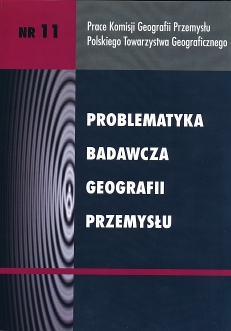Koncepcja efektów mnożnikowych w wyznaczaniu wpływu przedsiębiorstw na otoczenie społeczno-gospodarcze
DOI:
https://doi.org/10.24917/20801653.11.7Słowa kluczowe:
efekt mnożnikowy, otoczenie społeczno-gospodarczeAbstrakt
The subject of this paper is presentation of a method of calculating multiplier effects in order to determine the influence of enterprises on their environment. Emergence or development of economic activity in a given area may bring about an increase in income and employment in many other enterprises, as well as to an increase taxes collected by the local authority. This increase is labelled multiplier effects, and its value enables the evaluation of the enterprise’s activity on the functioning of neighbouring firms.In literature, the most frequently discussed types of multiplier effects are the supply and income effects. The first result from the demand created by the emerging and developing enterprises, which fosters the development of their goods and services suppliers. The second type, the income effects, result from the increase in purchasing power of the inhabitants, owing to the employees’ remuneration, and this means fostering the development of firms that satisfy consumers’ needs. These enterprises create greater demand themselves, thus triggering new cycles of multiplier effects.The calculation of created workplaces for the supply effects was conducted by using a designed algorithm. It allows calculating the new workplaces in the supplier firms on the bases of data concerning income of enterprises, participation of supply in the revenue, and employment-related costs. The growth of employment and payment is correlated with the increase in the income multiplier effects, generated by single enterprises. This work presents a scheme for calculation of new workplaces created as a result of new investments.Downloads
Metrics
Bibliografia
Bourque P. 1969, Income Multipliers for the Washington Economy, University of Washington, Center for Urban and Regional Research
Brucker S.M., Hastings S.E., Latham W.R. 1990, The Variation of Estimated Impacts from Five Regional Input-Output Models, „International Regional Science Review”, 13, 119–39
Conti S., 1993, The network perspective in industrial geography. Towards a model, „Geogr. Annaler”, 75 B, 3, 115–130
Conti S., Malecki E.J., Oinas P. (eds), 1995, The industrial enterprise and its environment, Aldershot, Avebury
Dicken P., Forsgreen M., Malmberg A. 1994, Local embeddedness and transnational corporations[in:] Globalisation, institutions and regional development in Europe, eds. A. Amin, N. Thrift, Oxford Univ. Press, Oxford, 23–45
Domański B. 2001, Kapitał zagraniczny w przemyśle Polski, Instytut Geografii i Gospodarki Przestrzennej UJ, Kraków
Domański B. 2004, Local and regional embeddedness of foreign industrial investors in Poland, Prace Geograficzne, Instytut Geografii i Gospodarki Przestrzennej UJ, Kraków
Domański B., Gwosdz K. (red.), 2005, Dziesięć lat doświadczeń pierwszej polskiej specjalnej strefy ekonomicznej. Mielec 1995–2005, UJ, Instytut Geografii i Gospodarki Przestrzennej, ARP o. Mielec, Kraków
Domański B., Gwosdz K., Huculak M., Wiedermann K. 2005, Oddziaływanie SSE Euro-Park Mielec na otoczenie lokalne. Powiązania firm i efekty mnożnikowe, [w:] Dziesięć lat doświadczeń pierwszej polskiej specjalnej strefy ekonomicznej Mielec 1995–2005, Instytut Geografii i Gospodarki Przestrzennej UJ, ARP o. Mielec, Kraków
Drake R.L. 1976, A Short-Cut to Estimates of Regional Input-Output Multipliers, „International Regional Science Review” 1, 1–17
Garnick D.H. 1970, Differential Regional Multiplier Models, „Journal of Regional Science”, 10, 35–47
Glickman N.J. 1971, An Econometric Forecasting Model for the Philadelphia Region, „Journal of Regional Science”, 11, 15–32
Grabher G. 1994, The disembedded regional economy: the transformation of East German industrial complexes into western enclaves, [in:] Globalization, institutions and regional development in Europe, eds. A. Amin, N. Thrift, Oxford Univ. Press, Oxford, 177–195
Hall O.P., Licari J.A. 1974, Building Small Region Econometric Models: Extension of Glickman’s Structure to Los Angeles, „Journal of Regional Science”, 14, 337–353
Hardy J. 1998, Cathedrals in the desert? Transnationals, corporate strategy and locality in Wrocław, „Reg. Stud.”, 32, 7, 639–652
Hayter R., Watts H.D. 1983, The geography of enterprise: a reappraisal, „Progress in Human Geogr.”, 7, 157–181
Lee Hansen W., Tiebout Ch.M. 1963, An Intersectoral Flows Analysis of the California Economy, „The Review of Economics and Statistics”, 45, 409–419
Lloyd P., Dicken P. 1972, Location in space: a theoretical approach to economic geography, Harper&Row, New York, San Francisco, London
Mattila J.M. 1973, A Metropolitan Income Determination Model and the Estimation of Metropolitan Income Multipliers, „Journal of Regional Science”, 13, 1–16
Myrdal G. 1957, Economic Theory and Under-Developed Regions, Duckworth, London
Sasaki K. 1963, Military Expenditures and the Employment Multiplier in Hawaii, „The Review of Economics and Statistics”, 45, 289–304
Scott A.J. 1988, New industrial space: flexible production and regional economic development in the USA and Western Europe, Pion, London
Sobala-Gwosdz A. 2000, The influence of large manufacturing firmson the local development of Jarosław in the 1990s, [w:] Local economy and urban development of Poland, red. T. Marszał, Wydawnictwo Uniwersytetu Łódzkiego, Łódź, 62–69
Stryjakiewicz T.red., 2004, Wpływ inwestorów zagranicznych na rozwój regionalny ilokalny, Bogucki, Wyd. Naukowe, Poznań
Tiebout Ch.M. 1957, Interregional Input-Output Models: An Appraisal, „Southern Economic Journal”, 24, 140–147
Weiss S.J., Gooding E. 1968, Estimation of Differential Employment Multipliers in a Small Regional Economy, „Land Economics”, 44, 235–244
Pobrania
Opublikowane
Jak cytować
Numer
Dział
Licencja
Artykuły publikowane są zgodnie z warunkami licencji Creative Commons (CC BY-ND 4.0; uznanie autorstwa-bez utworów zależnych).

